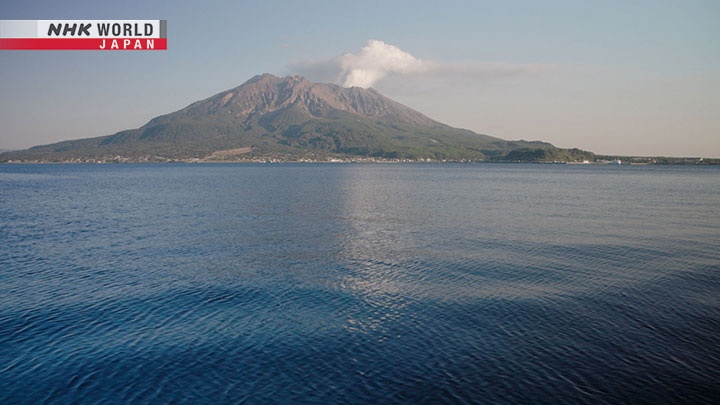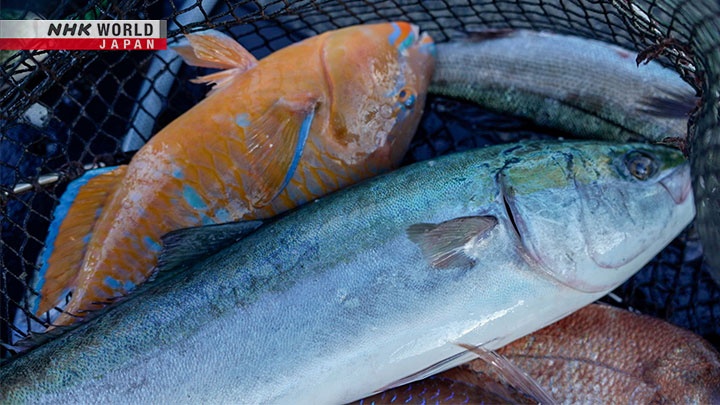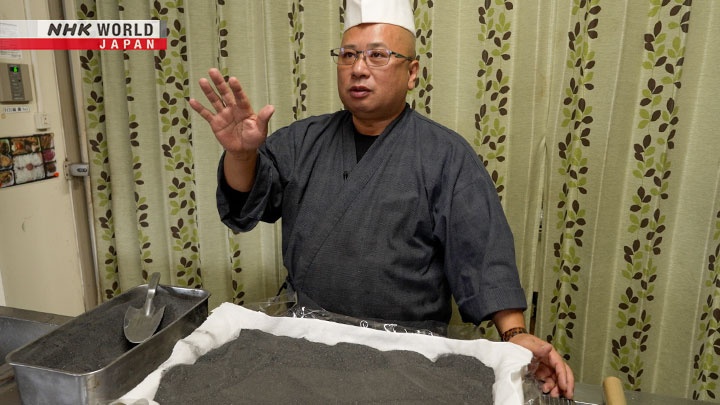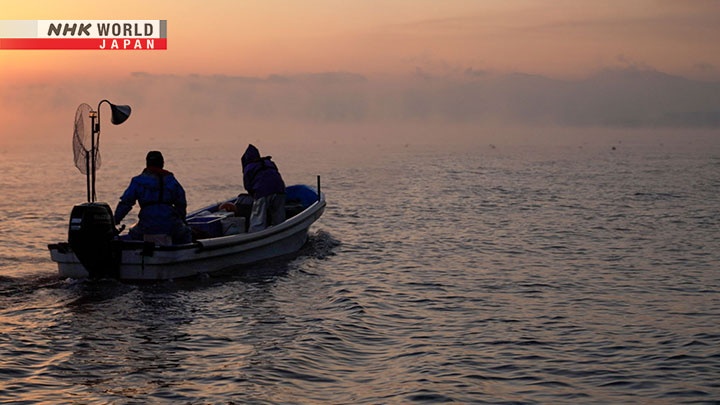A Feast Nurtured by a Volcano
Sakurajima, an active volcano in southern Japan. Surprisingly, there is a technique called “Haiboshi” that maximizes the flavor of seasonal fish using its volcanic ash. Let's explore the phantom technique that was once lost.






Transcript
Have you heard about the uniquely Japanese culture of "EKIBEN"?
Ekiben are lunch boxes sold at train stations that you can enjoy on your train journeys.
You'll find them brimming with various local charms.
Let's embark on a journey to encounter the best of Japan's Ekiben.
EKIBEN JAPAN!
In this episode, we're taking a look at an Ekiben with a deep connection to the active volcano Sakurajima:
the Sakurajima-Haiboshi Bento!
This Ekiben comes from Kagoshima Prefecture in Kyushu.
You're looking at Kagoshima Bay, created by Sakurajima's massive eruption about 30,000 years ago.
Look at this beautiful sea!
It's home to about 40 types of coral and over 1,000 species of fish.
It's truly a treasure trove of marine bounty!
Today, we're taking a ride on the IBUSUKI NO TAMATEBAKO,
running along a beautiful coastline, while enjoying a delightful Ekiben.
Let's see what's inside the Sakurajima-Haiboshi Bento purchased at the station.
It's impressively packed with 10 different items: a vibrant array of meat, fish and vegetables!
The star of the show is this beautifully grilled and sizeable fish fillet.
Now, let's see where this fish originally came from.
As golden hues begin to adorn Kagoshima Bay, a small fishing boat appears.
They're local fishermen, Mori Mitsuhide & Chitose, veterans of this trade for 20 years.
Each morning, they come to haul up the nets that were set the previous evening.
What's their catch?
Flounder.
Also...
Parrotfish.
And even more, harvested from the ocean's bounty.
This is a Marbled Rockfish, a high-grade catch.
They taste good fried or in Miso soup.
The Moris not only wholesale these fish to the market, but also sell them directly to locals.
They're much fresher, you see,
because the fish are prepared on the spot
before we take them home.
Sometimes it's tough because my hands get so cold.
Today was especially cold.
When we catch a big one,
it motivates us to work hard again.
In Kagoshima Bay, a variety of fish can be caught throughout the year.
The biggest catch of the day is this enormous Yellowtail.
Midwinter is peak season for this fish.
Mori is personally delivering these special fish.
- Hi.
- Hello.
He delivers them to a bento shop near the fishing port.
This is Nagi Shunko, the creator of the Sakurajima-Haiboshi Bento.
Thank you!
Please make something delicious with it.
It's not always determined which will be the main fish for the Ekiben.
Today, he is preparing the winter season Yellowtail,
as well as Parrotfish, a unique fish from the southern seas.
This is great quality.
It has an elastic texture.
It's as if the fat is clinging to the knife.
The Ekiben will feature the seasonal local fish rich in fat.
But this isn't your average grilled fish.
Haiboshi refers to "Ash-drying."
As suggested by the Ekiben's name, the fish is "ash-dried."
It's not a word you hear every day.
There's something essential to it...
The volcanic ash spewed out by Sakurajima, Kagoshima's iconic symbol.
Located just 4km away from Kagoshima City, where about 600,000 people reside,
Sakurajima remains an active volcano to this day.
In fact, there are years where it erupts more than 1,000 times.
This is the actual volcanic ash of Sakurajima.
You might be wondering how it can be used for Ekiben...
But it's actually essential!
It requires patient and diligent work.
First, the volcanic ash needs to be washed.
We want to get rid of the top layer.
See? Look at all of that.
The ash is washed repeatedly until there's no longer any debris floating to the surface.
After the debris has been removed, the ash is dried out in the sun.
It might dry pretty quickly.
The sun is so powerful.
It even has the effect of sterilizing.
The ash is dried and cleansed by sunlight for about 10 days.
Finally, after being baked in the oven at 300 degrees, the volcanic ash is ready for use.
And there you have it, the finished product.
This volcanic ash will work wonders on the fish.
First, the ash is spread out neatly, and a cloth is placed on top.
Next, fillets of fish from Kagoshima Bay are arranged on top of the cloth,
and then covered by a transparent film that allows moisture to escape.
Now we'll cover it with ash.
The fish is now completely sandwiched by volcanic ash.
It stays like this for three days.
When the volcanic ash is removed...
Hold on...
They don't appear to be dried.
They're close to being raw.
Fish are usually dried by exposure to air.
They oxidize, which is why they smell fishy.
With the ash drying method,
the moisture is removed without exposure to air.
The freshness is maintained,
and oxidation is prevented.
The volcanic ash absorbs the moisture containing the fishy smell.
It may enhance the umami flavor of the fish.
However, the true value of ash-dried fish is said to only be revealed after cooking.
Even after it's cooled down, it doesn't smell fishy.
That makes it great for Ekiben.
People can appreciate the "Ash-drying" method more
if they eat it cold.
That's why we created this EKIBEN.
It's not just fish.
He even ash-dries eggs by burying them in volcanic ash.
When left like this overnight, they become very delicious!
Using these ash-dried eggs, he prepares a thick Japanese-style omelette, rolling the egg into multiple layers.
It's one of the most popular items in the Sakurajima-Haiboshi Bento.
But why did Nagi start making Ekiben using volcanic ash in the first place?
Nagi, who had been working as a chef at a traditional Japanese restaurant,
encountered ash drying some 10 years ago.
He heard about dried seafood made using volcanic ash in port towns in Wakayama and Katsuura in Chiba, far from Kagoshima.
In fact, the volcanic ash they used came from Sakurajima in Kagoshima.
I was shocked.
Their websites were boasting about
how they sourced ash directly from Sakurajima.
They told me I'm a fool.
"Why aren't you utilizing a resource
that's literally raining down on you?"
Sakurajima is an active volcano that has erupted countless times throughout history.
The people of Kagoshima have feared the volcano, while also seeking ways to coexist with it harmoniously.
One way was the unique culinary culture of ash drying,
where foods such as meat, fish, vegetables, and tofu were dried using volcanic ash.
However, the laborious and time-consuming practice of ash drying eventually waned in popularity,
and Sakurajima's volcanic ash became a perceived nuisance, something that makes the city dirty...
Nagi revived a unique Kagoshima tradition that had long been forgotten.
Drying Kagoshima Bay fish using Sakurajima's volcanic ash.
People often ask me, "Why volcanic ash?"
100 years ago, everyone in Kagoshima was doing it.
The answer is simple.
There was an abundance of it right here.
It's truly one of a kind, a treasure of Kagoshima.
There's one more item with a deep connection to the volcanic ash of Sakurajima.
It's this pork simmered in sweet and savory sauce with ginger.
Kagoshima is famous for its black pigs.
But what makes these pigs special is their daily diet of sweet potatoes.
Kagoshima is well known for these, boasting the largest production volume in Japan.
Sweet potatoes tend to rot or become watery in moist soil.
However, in the soil of Kagoshima, full of Sakurajima's volcanic ash,
which provides excellent drainage and plenty of minerals, they grow exceptionally large and sweet.
Using sweet potatoes grown in these volcanic land as feed for the pigs...
Yields black pork known for its tenderness, rich flavor and sweet fat.
The ash is powerful
because it comes from an active volcano.
It's a blessing.
It's a blessing from the one-and-only Sakurajima,
so I want to make the most of it.
The power of Sakurajima's volcanic ash can also be experienced through this simmered pork.
Within this compact Ekiben, the Sakurajima-Haiboshi Bento,
we discovered the treasures of Kagoshima Bay and the power of the active volcano, Sakurajima.
What sort of Ekiben we'll encounter next?
EKIBEN JAPAN!
We look forward to welcoming you aboard again soon.